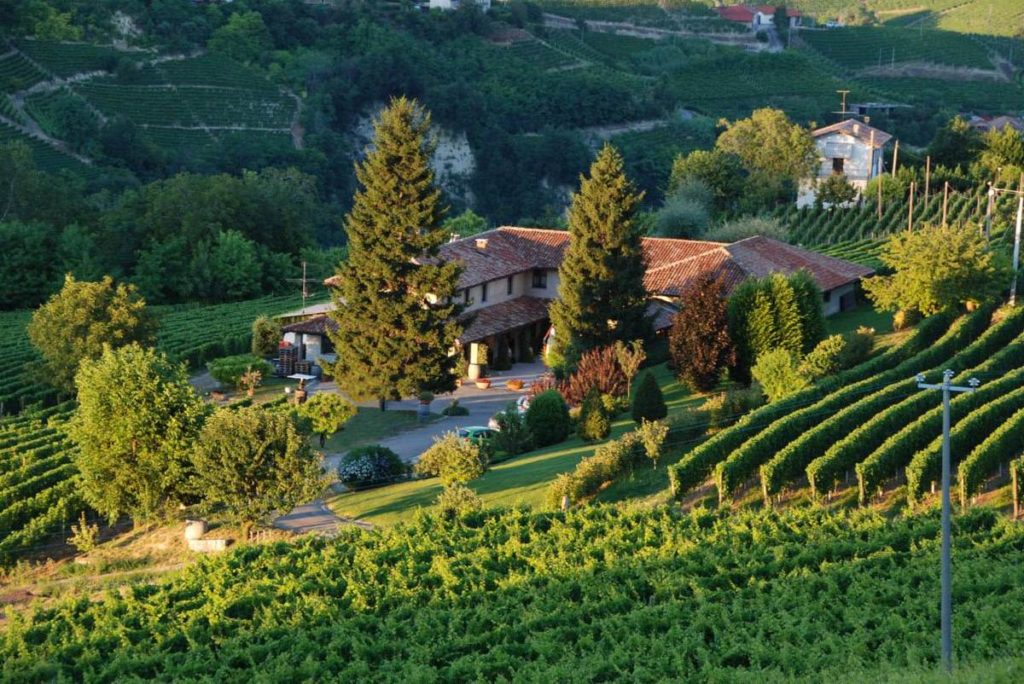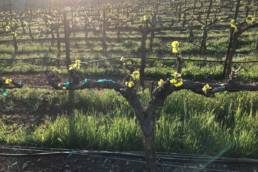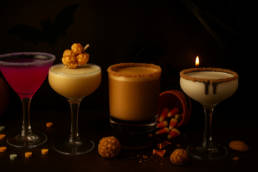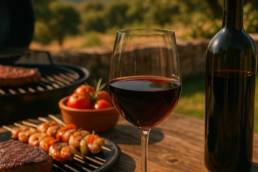Morning News – October 2024 – Italian Wines that Will Change Your Mind
For the benefit of all who follow the content pieces, promotional videos, and /or articles I muster up, a healthy (or unhealthy) amount of wine is tasted. Unfortunately, even with this voluminous amount of juice passing my lips, much of it seems pedestrian and uninspiring. Staying true to my convictions, only wine (and spirits) that beguile my palate make the cut for content inclusion.
On occasion, for a multitude of sometimes inexplicable reasons, the juice in my glass will be captivating enough to make me take pause. In this instance, it was admittedly my own prejudicial ignorance that was given a trip to the proverbial tool shed. The Moscato and white international varieties from a recent Piedmont tasting forever changed the way I approach and discuss these wines.
Alessandro Varagnolo’s Moscato Will Change Your Mind
The production of internationally recognized varieties alongside Piedmonte’s usual suspects was geared toward gaining international market share. Although, initially, this strategy had varying levels of success, it opened the door to future growth and exploration. What used to be relegated to the “entry level” category for these producers, has now blossomed into wines that are taken seriously among world-wide competitions.
category for these producers, has now blossomed into wines that are taken seriously among world-wide competitions.
Alessandro Varagnolo’s forward thinking shone through when taking control of the Ca’ d’Gal estates and vineyards, in Piedmont, Italy. One project that focused on their international varieties took a previously blended wine, Chardonnay and Sauvignon Blanc, and produced two separate varietal wines. The Sauvignon Blanc would fill the portfolio void for an acid-driven wine while allowing the winemaker creative license with the table rasa of all grapes, Chardonnay. The styles are palatal bookends for dry white wines and both are a resounding success in their own right.
Although these international white wines were a pleasant surprise, the true stunner was Ca’ d’Gal’s use of the Moscato grape. Before you abandon reading and surrender to that guttural response at the mere mention of Moscato, hear my confession. I too was guilty of pigeonholing all Moscato wines as cloyingly sweet and one-dimensional. But even this old dog can be taught a new trick when willing.
Not All Muscat is the Same
To fully appreciate these wines, one must understand that not all Muscat grapes are the same. If there is a perceived hierarchy of the Muscat family, then Piedmont’s Moscato Bianco, also known as Muscat Blanc À Petits Grains, would be at the top of the pyramid.
This grape is grown all over the world and, although adding some interest and complexity to many dry white blends, it truly shines in the sweet wines. Some of the best dessert wines in the world like France’s Muscat de Rivesaltes and Beaumes-de-Venise, Hungary’s Tokaji and even South Africa’s Klein Constantia contain this type of Muscat. Although the quality and seductiveness of these wines cannot be ignored, even the simplest brand of Moscato outsells them all on the world marketplace.
 Moscato Bianco remains the most grown white grape in all of Piedmont, and almost all of this goes into the sweet and fizzy wines produced in and around the Asti region. The stigma that these wines are cheap and syrupy sweet is not completely unfounded. Much of this production style is based on volume rather than quality and the Martinotti method (second ferment in tank) is far less expensive and quicker versus traditional method (Champagne).
Moscato Bianco remains the most grown white grape in all of Piedmont, and almost all of this goes into the sweet and fizzy wines produced in and around the Asti region. The stigma that these wines are cheap and syrupy sweet is not completely unfounded. Much of this production style is based on volume rather than quality and the Martinotti method (second ferment in tank) is far less expensive and quicker versus traditional method (Champagne).
Some producers will choose to purposefully slow the ferment to increase the complexity of the wine and the caressing mouthfeel of the bubbles. In addition, the delicate balance of acid and residual sugar can be the difference between tasting like soda pop and quality wine. Moscato of Ca’ d’Gal takes both of these quality improvement steps along with treating the vineyards and grapes as though they were going into a grand cru wine. These production decisions alongside the vineyard altitude and soil compositions make for a truly unique and complex expression that is unlike any Moscato I’ve ever tasted.
Chianti Discovery

Another recent discovery will appeal to those that refuse to accept that wine with some residual sugar can be delicious and quality-driven. Although I will refer you to some of the most complex and integrated Chianti I’ve ever poured in my gob, do not mistake my capitulation for agreement.
Great liberties are taken with wines labeled Chianti. Even though they must follow the guidelines for the right to use that “brand,” there are a multitude of variances with quality, blends and terroir expressions. I recently had the opportunity to taste through a large portion of the Vecchie Terre di Montefili portfolio and it reassured me that the region is headed in the right direction.
Serena Gusmeri, Chianti Superstar
How an outsider, someone without ties to Tuscany, can end up as a winemaker there is an uphill battle. Pair that with the fact that the winemaker is female and it becomes almost an impossibility. Somehow Serena Gusmeri, a native of Brescia, has not only achieved this but gained the respect of fellow Chianti winemakers.
 This former scout leader, nature lover, and agronomist now makes terroir driven wines at the top of the historic and panoramic Monte Fili hill. You may think that most Chianti tastes relatively similar, after all it is grown in the same region and must have a dominant amount of Sangiovese in the blend. The wines that she produces, however, will make you challenge your preconceptions of what Chianti is and what it truly can be.
This former scout leader, nature lover, and agronomist now makes terroir driven wines at the top of the historic and panoramic Monte Fili hill. You may think that most Chianti tastes relatively similar, after all it is grown in the same region and must have a dominant amount of Sangiovese in the blend. The wines that she produces, however, will make you challenge your preconceptions of what Chianti is and what it truly can be.
Perhaps their secret is in the high-altitude location (1700 feet above sea level) or the vineyards being surrounded by wooded areas and olive groves. If you ask Serena, she will tell you that the quality comes from the biodiversity of their soil, something they have won awards and certifications for. At Montefili, this diversity is taken so seriously that each vineyard is vinified separately. When tasting through the portfolio, I was amazed at the unique personality of each wine. Even their “entry level” Chianti wines are a misnomer as the quality and complexity is ridiculous at that level.
So, I hope you take the opportunity to explore both of these very different representatives of Italian wine. Although my selections are abridged for the sake of time and print space, I invite you to sample through both producer’s portfolios as I can assure you will be pleasantly rewarded.
Suggested Wines
Ca’ d’Gal Piedmont DOC Sauvignon 2023 ($23)
This 100% Sauvignon Blanc has aromas of freshly cut leafy herbs, brined citrus zest, orchard fruit and white floral note. The palate is dry with a textural element that nods to the prolonged lees contact and bâtonnage. Flavors of pear nectar quickly morph to brined citrus fruit, and mouthwatering mineral-laden acidity. Pair with seafood on the half shell (oysters, clams), cheeses (brie, goat cheese), and grilled white fish.
Ca’ d’Gal Asti Spumante DOCG ($20)
The wine has a complex and overt nose showing aromas of apricot, musky grape, sage leaf, yellow apple, tea leaves and a perfumed note (dried flowers). The arrested ferment shows a palate that has less perceptible sweetness than expected for 80-90 g/L residual sugar; showing great balance. There are flavors of elderflower, sage, apple, apricot wrapped inside a creamy mousse. Pair this with salty aperitifs (cured meats, roe), fruit desserts (apricot pastry) or (at 7%abv) drink with blatant disregard.
Ca’ d’Gal Lumine Moscato d’Asti DOCG 2023 ($26)
This vintage Moscato hails from vineyards between 20 and 45 years of age. The nose boasts aromas of spice (sage, rosemary and cardamom), lemongrass, musk, peach, and apricot. The semi-sparkling perlage is lively carrying with it flavors of peach, apple, pear, sage and lemongrass. The sweetness is supported with an acid core that offers a freshness. Pair this wine with everything from hazelnut-based desserts, pumpkin bread, or gorgonzola.
Vecchie Terre di Montefili Chianti Classico 2020 ($35)
This 100% Sangiovese sees 15 months minimum in 30hL botti and shows complex aromas of berry compote (blackberry, currant, cherry), fig, crushed dried woody herbs, slight cedar, and a spice (white pepper, clove). The palate is dry with classic dusty but not overtly astringent tannins and tart acidity. There are flavors of cherry, cranberry, and herbs in a cedar box. Pair with cured meats, veal, meat-based pasta sauces, Margherita pizza.
Vecchie Terre di Montefili Chianti Classico Gran Selezione 2019 ($45)
This 100% Sangiovese sees a bit more age, 24 months in 20hL botti. The nose has dark fruit (blackcurrant, blackberry, plum), sweet baking spice (allspice, cinnamon) and a slight cedar box note. The dry palate with dusty, only slightly gipping tannins and tart acid core. The palate mirrors the nose with a slight woody herbal note emerging. Pair with salted ribeye, spaghetti Bolognese, or the classic Ribollita.




